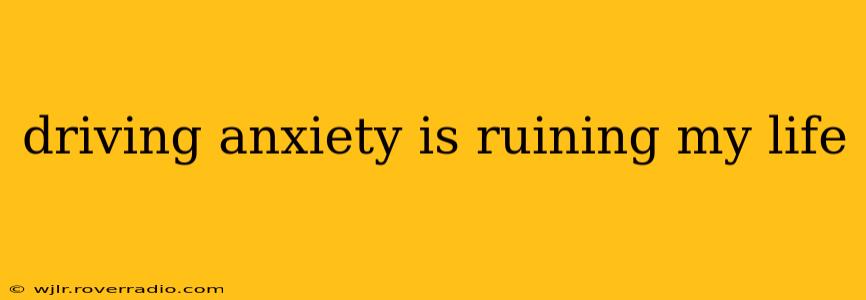Driving anxiety, or Amaxophobia, is more than just feeling a little nervous behind the wheel. For many, it's a debilitating condition that significantly impacts daily life, relationships, and overall well-being. If you're struggling with driving anxiety that's "ruining your life," know that you're not alone, and help is available. This comprehensive guide explores the causes, symptoms, and effective treatment strategies for overcoming driving anxiety and regaining control of your life.
What Causes Driving Anxiety?
Driving anxiety stems from a complex interplay of factors. Understanding these root causes is the first step towards effective management.
- Past Traumatic Experiences: Accidents, near-misses, or witnessing serious car crashes can deeply imprint fear and anxiety related to driving. These traumatic memories can trigger intense physical and emotional responses even years later.
- Fear of Loss of Control: The feeling of being in control of a powerful machine, responsible for your safety and the safety of others, can be overwhelming for some individuals. Loss of control fears can be amplified by physical sensations like dizziness or nausea.
- Social Anxiety: Driving can exacerbate social anxieties, particularly in situations like navigating busy traffic, parking in tight spaces, or interacting with other drivers. The judgment of others can heighten feelings of self-consciousness and anxiety.
- Specific Phobias: Certain aspects of driving, such as driving on highways, driving at night, or driving in tunnels, can trigger intense phobias. These phobias can be rooted in specific fears, such as fear of speed, enclosed spaces (claustrophobia), or open spaces (agoraphobia).
- Generalized Anxiety Disorder (GAD): Individuals with GAD often experience excessive worry and anxiety across various life situations, and this can manifest as driving anxiety. The inability to control anxious thoughts and feelings makes driving a particularly challenging experience.
- Panic Disorder: The unpredictable onset of panic attacks can make driving intensely frightening. The fear of experiencing a panic attack while driving can create a vicious cycle of anxiety and avoidance.
What are the Symptoms of Driving Anxiety?
Recognizing the symptoms of driving anxiety is crucial for seeking appropriate help. These symptoms can range from mild discomfort to severe incapacitation:
- Physical Symptoms: Rapid heartbeat, sweating, shortness of breath, trembling, nausea, dizziness, chest pain, muscle tension.
- Emotional Symptoms: Fear, panic, overwhelming anxiety, irritability, feeling trapped or helpless.
- Behavioral Symptoms: Avoiding driving altogether, only driving in familiar areas, needing a companion to drive with you, experiencing intense distress before or during driving.
How Can I Overcome My Driving Anxiety?
Overcoming driving anxiety requires a multifaceted approach, often involving a combination of therapies and self-help strategies.
1. Cognitive Behavioral Therapy (CBT):
CBT is a highly effective therapy for anxiety disorders. It helps identify and challenge negative thought patterns and behaviors related to driving. Through gradual exposure techniques, individuals learn to manage their anxiety responses in driving situations.
2. Exposure Therapy:
This therapy involves gradually exposing yourself to driving situations that trigger anxiety, starting with less anxiety-provoking scenarios and gradually progressing to more challenging ones. A therapist guides this process, providing support and coping mechanisms.
3. Relaxation Techniques:
Practicing relaxation techniques such as deep breathing exercises, meditation, or progressive muscle relaxation can significantly reduce anxiety symptoms during and before driving. These techniques help calm the nervous system and reduce physical tension.
4. Medication:
In some cases, medication may be necessary to manage severe driving anxiety symptoms. Anti-anxiety medications or antidepressants can help reduce anxiety levels and improve overall mood, making it easier to cope with driving-related anxieties. Consult a doctor or psychiatrist to determine if medication is appropriate for your situation.
5. Professional Driving Lessons:
Professional driving instructors specializing in anxiety management can provide tailored instruction and support, building confidence and skills in a safe and supportive environment.
What if I'm Afraid of Driving on Highways?
Highways can be particularly anxiety-provoking due to high speeds, heavy traffic, and the feeling of being surrounded by large vehicles. Gradual exposure techniques, starting with shorter distances on less busy highways and gradually increasing the duration and traffic density, can be highly effective. Professional driving lessons focusing on highway driving can also be incredibly beneficial.
What if My Driving Anxiety is Preventing Me from Going to Work?
Driving anxiety significantly impacting your ability to work requires immediate attention. Discuss your concerns with your employer and explore options such as working remotely, adjusting your work schedule, or using alternative transportation methods until your anxiety is better managed. Seeking professional help is crucial to address the underlying anxiety and regain your ability to commute safely.
What if Driving Anxiety Makes Me Feel Trapped?
Feeling trapped by driving anxiety is a common experience. Recognizing that you are not alone and actively seeking help is a significant step towards overcoming this feeling. Therapy, support groups, and self-help strategies can provide tools and coping mechanisms to regain a sense of control and freedom.
Is There Anything I Can Do at Home to Reduce My Driving Anxiety?
Yes! You can implement several self-help strategies at home:
- Practice relaxation techniques: Deep breathing, meditation, and progressive muscle relaxation can significantly reduce anxiety.
- Visualize successful driving experiences: Mentally rehearse driving scenarios, focusing on positive outcomes and feeling confident behind the wheel.
- Challenge negative thoughts: Identify and challenge negative thoughts and replace them with more realistic and positive ones.
- Keep a journal: Document your anxieties, triggers, and coping strategies to track your progress and identify patterns.
Driving anxiety doesn't have to control your life. By understanding its causes, recognizing your symptoms, and implementing effective strategies, you can reclaim your freedom and confidence behind the wheel. Remember, seeking professional help is a sign of strength, not weakness, and is often the most effective path to recovery.
